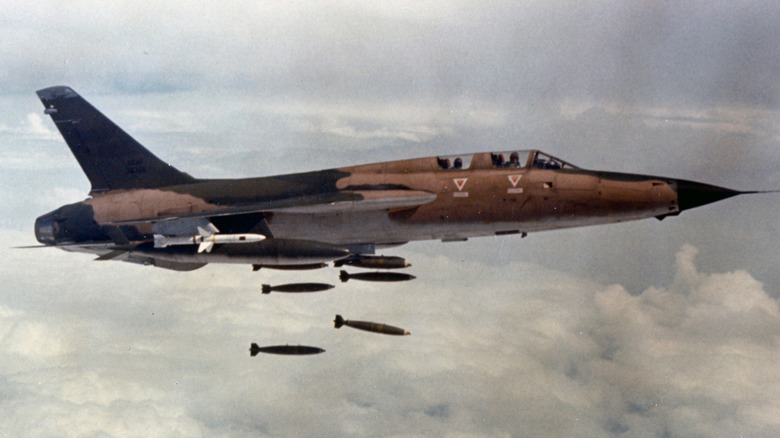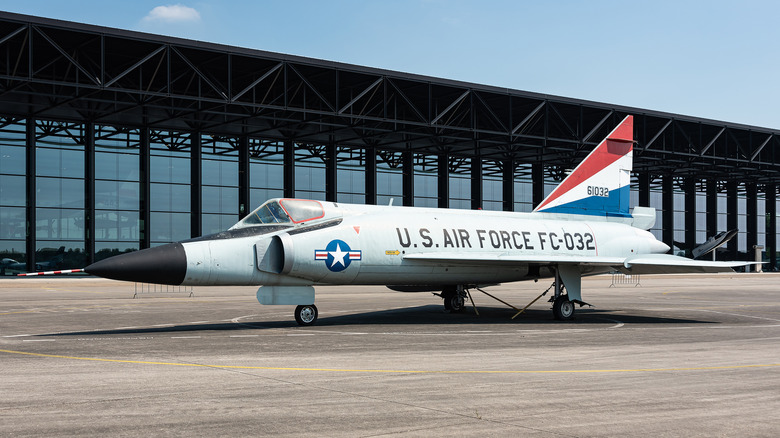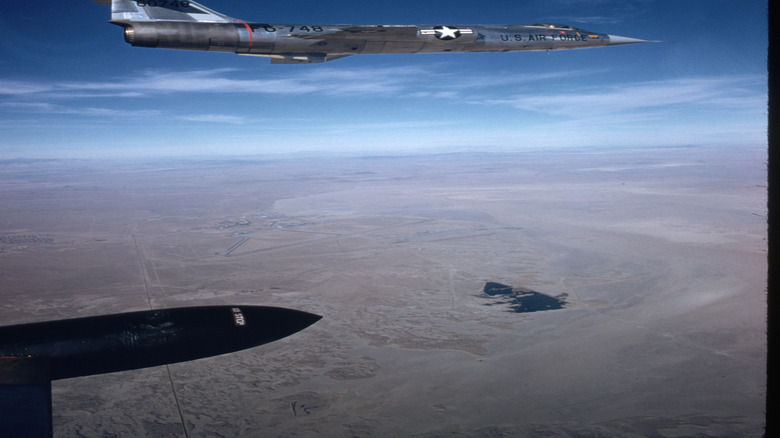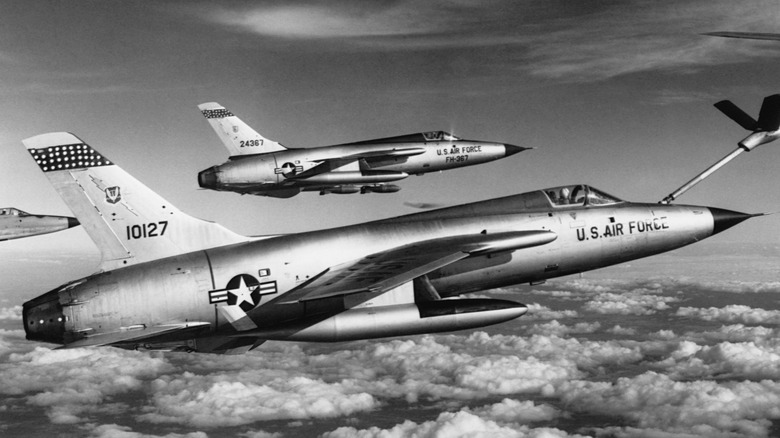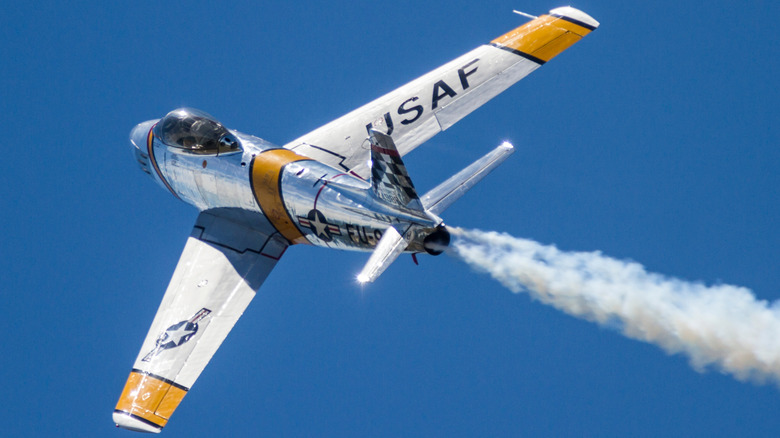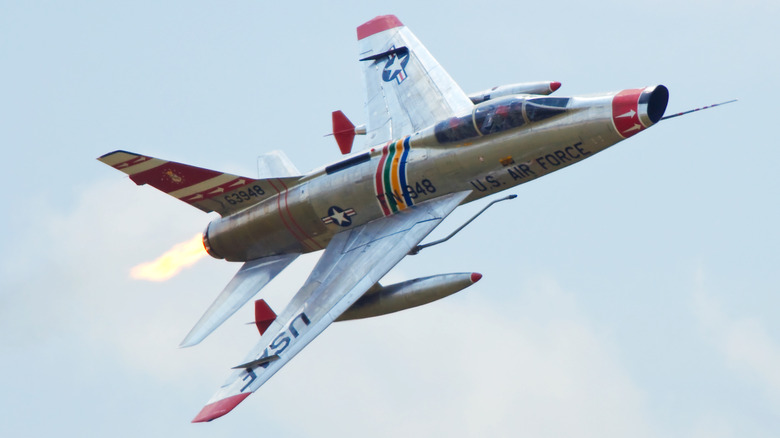5 Worst Fighter Jets To Fly For The US Air Force
The U.S. Air Force has been a crucial part of the U.S. military in numerous key moments in the history, such as the Vietnam War and the Afghanistan War. Engineering marvels such as the F-22 Raptor and the F-35 Lightning have cemented the U.S. Air Force's dominance in modern aerial warfare. However, the now-dominant Air Force hasn't always had this unfailing fortune with their fighter jets. Several fighter jets that aspired to be a cut above the rest with their speed and design often ended up duds, especially during the inception of jet-propelled fighters.
Jet engines brought a massive thrust boost to fighter planes when compared to the piston-based alternatives. The increase in thrust and greater height tolerance also meant a complete redesigning of various elements such as the wings and airframe to withstand the high-speed maneuvers. Moreover, the unreliability of the new engine always remained a problem with initial generations of fighters, for which some initial fighters also used a hybrid of piston and jet engines. As a result, several over ambitious jet fighters performed poorly due to failing one or many aspects of integrating the jet engine. Let's gloss through history and look at some of the worst fighter jets to be a part of U.S. Air Force's fleet.
F-102 Delta Dagger
As the Cold War intensified, the Soviet long-range bombers started becoming a major concern for the U.S. The U.S. Air Force badly needed supersonic jet interceptors to detect the Soviet bombers and destroy them midair. Enter the F-102 Delta Dagger, the world's first interceptor designed to achieve supersonic speeds. Unfortunately, the Delta Dagger was riddled with some serious design flaws since its inception.
Convair had to completely redesign the wings from scratch after discovering they couldn't support supersonic speeds. Next in line was the faulty fuselage that produced abnormally high drag, restricting the Delta Dagger from reaching Mach 1. After repeated modifications, the F-102 could eventually reach supersonic speeds, but under very specific conditions. Apart from these performance issues, the Delta Dagger faced 468 minor and major accidents, resulting in 49 casualties during its lifetime.
The Delta Daggers were later deployed in the Vietnam War in air patrols and as bomber escort planes. Additionally, the Air National Guard used the F-102 during the late 60s and early 70s.
F-104 Starfighter
Similar to other mentions on this list, the F-104 Starfighter was yet another trailblazer. The Starfighter was the first to sustain the Mach 2 milestone during flight. However, groundbreaking innovations often come with their own challenges, and the F-104 Starfighter was no exception. Despite its blazing fast speeds, the Starfighter suffered from high landing speeds, short range, and an unreliable engine for almost all of its lifetime under the U.S. Air Force, earning it the nickname of "the rocket with a man in it."
The F-104 wasn't a complete failure, as it served close to 5000 sorties during the Vietnam War where it primarily escorted the EC-130 motherships. Even after its retirement from the U.S. Air Force in 1969, it continued serving in foreign militaries such as Canada, Germany, Pakistan, and Italy. Despite widespread adoption, the F-104 was prone to accidents, with its abysmally high rate of 30 mishaps per 100,000 flight hours. Canada and Germany lost 50% and 30% of their entire F-104 fleets respectively in crashes, earning it another infamous title of 'Widowmaker'.
Republic F-105 Thunderchief
The Republic F-105 Thunderchief entered service in the 1950s as a Mach 2 capable aircraft for the U.S. Air Force. The iconic F-105 was initially conceived of as a nuclear payload delivery jet, as it was intended to carry a nuclear weapon at high speeds and at low altitudes for deep penetration of enemy airspace. Instead, it became one of the U.S.' primary attack aircraft during the early years of the Vietnam War, but limited maneuverability and other problems plagued the heavy, rugged fighter that saw it removed from combat.
The F-105 had plenty going for it, including an ability to carry more ordnance than a WWII-era B-17 Flying Fortress and an impressive cruising speed of 778 mph. Unfortunately, while it had some positive aspects, the F-105 was called the "Thud" by its operators and maintainers for its weight and penchant for blowing up midair. The aircraft holds the dishonorable distinction of having the highest non-combat accident rate of any fighter the Air Force has ever employed.
Additionally, it's also the only fighter pulled from combat operations because of its heavy loss rate. Out of the 833 F-105s produced, 320 were lost in combat during the Vietnam War. Part of the danger stemmed from fuel leaks and overheating, which resulted in midair explosions. A modification solved the problem, but much of the damage had already been done. By the end of its service life, 612 F-105s were lost to various causes, amounting to a total loss rate of 73.5%.
North American F-86 Sabre
The North American F-86 Sabre was the United States' first swept-wing fighter, introduced in 1948, making it one of the earliest aircraft designed for the newly created Air Force. The F-86 dominated the skies during the Korean War as a counter to the Soviet MiG-15, which it would engage in dogfights. The F-86 was introduced at a time when fighters were transitioning from propeller-driven means to jets, and this caused some problems for many pilots and their aircraft, including the F-86.
While it served the Air Force and its pilots well, it was notoriously difficult to fly. Those previously familiar with propeller-driven fighters had difficulty adapting to the jet-powered F-86. Other things to which pilots had to adapt included the F-86's swept-wing design, all-flying tail, fully movable stabilizer, and its limited ceiling of 49,000 feet.
Another major concern was the jet's performance on takeoff, which often saw it over-rotate. Over-rotation during takeoff can result in a tailstrike and possibly a stall, which can be difficult for any pilot to overcome. This resulted in a high accident rate, including an over-rotation at the Golden West Sport Aviation Air Show in Sacramento, California, in 1972. The fighter, which was a Canadair Sabre variant of the F-86, crashed into a nearby ice cream parlor, killing 22 people.
F-100 Super Sabre
The North American F-100 Super Sabre was the first of the Century Series jet fighters, all of which were plagued with problems. The F-100 was designed to be a successor to the F-86 Sabre, and it entered into service in 1954. While it seemed promising from the start, there were problems that resulted in numerous accidents and fatalities. Because of this, the F-100 was grounded only two months after its introduction so it could overcome these issues, and it didn't fly again until early 1955.
That's not a great start for any fighter jet, but it went on to serve during the Vietnam War as the U.S. Air Force's primary close air support fighter jet. Multiple variants of the F-100 were built throughout its service life, and the fighter had many impressive features. It was the Air Force's first fighter capable of sustained supersonic speeds in level flight.
One of the biggest problems with flying the F-100 was its high accident rate. These were often caused by wing fractures, compressor stalls, and yaw instability. Of the 2,294 built, 889 were lost in accidents, resulting in a loss rate of 38.75%. It also had an operational high loss rate, as 186 were lost to enemy anti-aircraft, seven to ground forces, and 45 more due to operational accidents.
